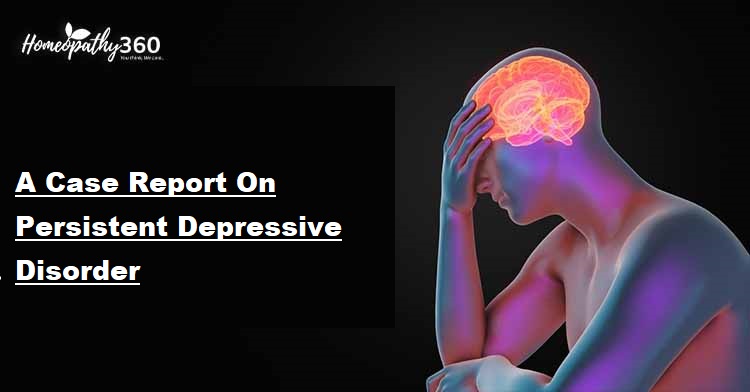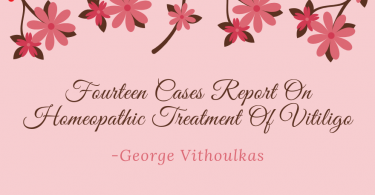
Usefulness of individualized homoeopathic medicine in Persistent Depressive Disorder (Dysthymic disorder).
INTRODUCTION
Persistent depressive disorder (formerly dysthymic disorder) is characterized by chronic low-level depression that is not as severe, but may be longer lasting than, major depressive disorder. A diagnosis of persistent depressive disorder requires having experienced a combination of depressive symptoms for at least 2 years. Globally dysthymia occurs in about 105 million people a year (1.5% of the population). It is slightly more common in women (1.8%) than in men (1.3%). The lifetime prevalence rate of dysthymia in community settings appears to range from 3 to 6% in the India. Depression is one of the common complaints for psychiatric consultancy to a Homoeopath. This aims to assess the effectiveness and safety of homoeopathy in Depression.
A CASE REPORT
Preliminary data
Date – 19/12/2022
Registration-no.- 66390
Patient Name- Mr. R.B
Age/ Sex- 21/M
Socio-economic status- Middle class
Occupation- GNM Student
Religious/ Nationality- Hindu/ Indian
Hometown Address- Delhi ( Panjabi bagh)
Dietry Habit- Veg
Chief Complaints
| LOCATION | SENSATION | MODALITIES | CONCOMITANTS |
| MINDSudden D-June 2020P-Progressive | Homesickness+3Lack of confidence+3Lack of interest+3-Excessive thoughts+3Worried about family+3Low mood+3 | < AloneCompany |
Physical Generals
| Appearance | Wheatish complexion, average height,smiling face | Perspiration | Normal, more on back, smelly |
| Appetite | 3 meals/Day | Tongue | – |
| Thirst | 2-3 Glass/ Day | Sleep | Sound sleep |
| Desire | Cold water | Dream | – |
| Aversion | – | Thermal | Towards Hot |
| Craving | Sweet+3 | Bathing habit | Regular |
| Stool | 1 time/ Day,Satisfactory | Sexualfunction | – |
| Urine | Clear, D4-5, N0-1 | Menstrualfunction | – |
| Any food/ medicine allergy/ drug history | N.S | ||
Parents/Mother’s Obstetrics History
NS
Developmental Landmarks
Milestones On Time
Past History
NS
Family History
Father- Accidental, HTN
Mother- OA, DM, Heart Attack
Life Space
A wheatish complexion, smiling face , 22 years male patient came to the OPD. He was born & brought up at Delhi.
His family consists of Mother, Father and 3 Sibling (Sisters).He told that he was shy and average in study during childhood.
He scored 80% in 12th and moved Jaipur in June 2021. Normally, family environment is good but he is not allowed to go outside after 8pm.
His father is strict in nature. He likes to stay at home but his parents don’t allow him to stay there (Hometown). Socially he is very active and has many friends and easily mixes up with people.
He had relationship of 5 years but got breakup because that girl got married.
There is disappointment of love. Patient has the fear of father but still wants to go back to the home and help his parents.
He told that his anger is violent and become abusive during anger that is why his father does not want him to stay at home. He is still angry with his ex girlfriend and wants to take revenge from her but did not do anything with her.
His emotions are suppressed and does not want to share his things with anyone.
Responsible in nature.
Diagnosis
Persistent Depressive Disorder (Dysthymic disorder)
Analysis and Evaluation of Symptoms
| Mental Symptoms | Physical Symptoms | Particular Symptoms |
| HomesicknessLack of interestLack of concentrationLow mood Excessive thoughtsEmotions suppressed< Alone> CompanyA/F Disappointed love Fear of being cheated | Desire- sweetDesire- cold waterDesire- warm foodPerspiration – smelly | – |
Totality Of Symptoms
- A/F Disappointed love
- < Alone
- > Company
- Homesickness
- Low mood
- Emotions suppressed
- Desire for sweet
- Desire for warm food
- Perspiration smelly
Repertorial Totality
- MIND- Ailments from; love disappointment
- MIND- Company- Desire for – alone aggravation; when
- MIND- Emotions- suppressed
- MIND- Homesickness
- MIND- Morose
- GENERAL- FOOD & DRINK- sweet- desire
- GENERAL- FOOD & DRINK- Warm food- desire
Repertorial Result
- Nat. Mur 6/11
- Phosphorus 6/11
- Calcarea 6/10
- Causticum 6/10
- Ignatia 5/12
- Phos. Acid 5/11
- Lyco 5/10
Prescription
After Repertorization, Here, Phosphorus was selected on the basis of constitution of the patient.
Phosphorus 1M/ Stat/ 1 dose
was given to the patient on 19th December 2022.
Follow ups
| Date | Remedyresponse | Interpretation | Prescription | Reason | Expectation |
| 3/2/2023 | Homesickness- | Better | Rx | Need to | There |
| controlled | 1. Phosphor | repeat the | should be | ||
| Lack of | us 1M/ 1 | dose for | relieve | ||
| confidence- | Dose/ Stat | better | |||
| 20% ↓ | 2. Saclac | improvement | |||
| Low mood- | 200// OD X | ||||
| 20% ↓ | 15 Days | ||||
27/2/2023 | Feeling better- | Better | Rx | Medicine | Symptoms |
| 40% ↓ | 1. Saclac | responding | should be | ||
| Homesickness- | 200/ 1 Dose/ | well, need to | relieved | ||
| Absent | Stat | wait & watch | |||
| Lack of | X 15 Days | ||||
| confidence- | |||||
| 40% ↓ | |||||
| Low mood- | |||||
| 50% ↓ | |||||
27/3/2023 | Feeling better- | Better | Rx | Medicine | Symptom |
| 80% ↓ | 1. Saclac | responding | Can be | ||
| Homesickness- | 200/ 1 Dose/ | well, need to | constant | ||
| Absent | Stat | wait & watch | |||
| Lack of | X 15 Days | ||||
| confidence- | |||||
| 80% ↓ | |||||
| Low mood- | |||||
| 80% ↓ | |||||
| All PG- | |||||
| normal | |||||
21/4/2023 | All the | Improved | Rx | Improved , | Old |
| complaints – | Saclac | no need to | symptoms | ||
| Absent | 200/ 1 Dose/ | give | can be | ||
| No new | Stat | medicine, | reappear | ||
| symptoms | X 15 Days | only for | |||
| All PG- | mental | ||||
| Normal | satisfaction | ||||
| of the patient |
| 5/5/2023 | Lack of concentration Low mood Excessive thoughts Homesickness | Old symptoms reappear | Rx 1.Phosphorus 1M/ 1 Dose/ Stat | Need to repeat the medicine | There should be relief |
| 12/5/2023 | Lack of concentration- SQLow mood – SQExcessive thoughts- SQ Homesickness- SQ | No change | RxThuja 1M/ Stat.Phosphor us 1M/ 1 Dose/ HSX 15 Days | Need to give Intercurrent medicine | There should be relief |
Discussion
Patient came to the OPD with the symptoms of Persistent Depressive Disorder. Phosphorus 1M was given to him on the basis of his constitution. There was relief in the the symptoms. Two scales were applied in the patient. First one was the PSS Scale (Perceived Stress Scale) which was used during screening with the score of 22 and SSI (Student Stress Inventory ) was the Second scale which was applied pre and post treatment. There was changes in the score, pre score was 71 and post treatment was 51.





